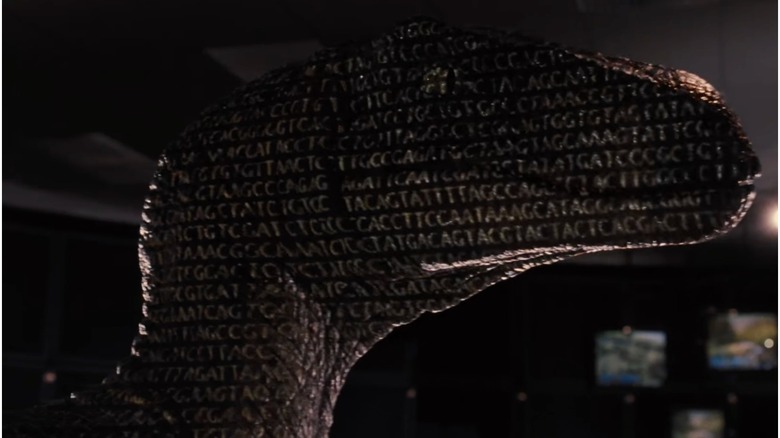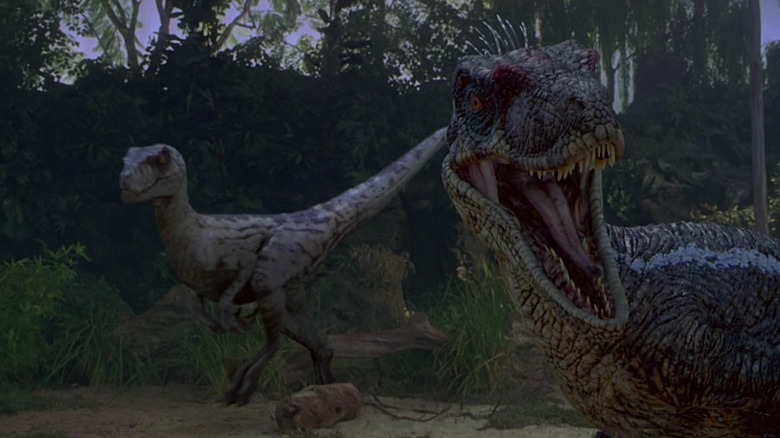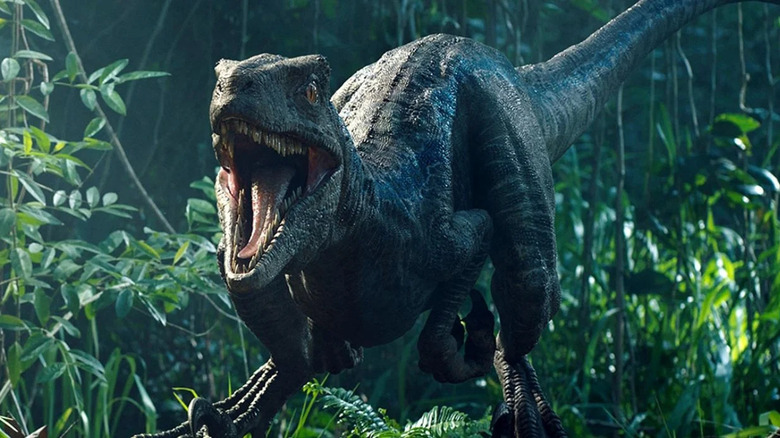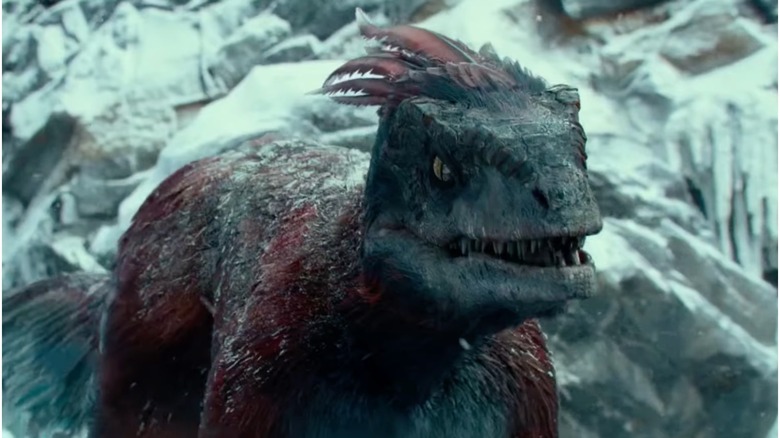How Realistic Are The Jurassic Movies' Velociraptors? A Paleontologist Has The Answer
The most famous dinosaurs in the "Jurassic Park" series, eclipsing even the Tyrannosaurus rex, are the Velociraptors. These calculating pack hunters have appeared in all six "Jurassic" movies, serving as the most persistent (and terrifying) threat in the "Park" trilogy before being thrust into the unlikely (and ridiculous) role of hero in the following "World" trilogy.
You probably don't need to be told that "Jurassic Park" leaves something to be desired when it comes to scientific accuracy. The Velociraptor's depiction is one of the most egregious. Outside of the name, the cinematic version isn't even a depiction of the real-life animal. So, which dinosaur(s) are the "Jurassic Park" raptors based on? Strap in folks, we're going full paleontology geek.
Paleontology lesson
The main species of Velociraptor is V. mongoliensis. True to its name, the fossils from which it is known were discovered in Mongolia and date back to about 75 million years ago. These animals were also about the size of a turkey, a far cry from the six foot tall man-eaters from "Jurassic Park." Funnily enough, before Alan Grant (Sam Neill) scars a kid (Whit Hertford) for life with a tale of how Velociraptors hunted, the kid quips that a raptor looks like a "six foot turkey" — looks like he wasn't far off.
So, why are the "Jurassic Park" raptors so much bigger than they were in real life? The easiest answer is because they're scarier that way, but it's also because author Michael Crichton modeled his raptors on a larger, North American cousin of the Velociraptor.
The animal in question is Deinonychus, aka d. antirrhopus. This name is Greek for "Terrible Claw," a fitting name given the raptor's sickle-shaped foot claw which its onscreen counterparts share. The Deinonychus lived about 40 million years before the Velociraptor in what is now the western United States. Despite the long geographic and temporal distances between them, and Deinonychus being twice as large, the two are classified as close relatives.
The first Deinonychus fossils were discovered in 1969 in Montana by paleontologist Jon Ostrom. The discovery is credited with reigniting public interest in dinosaurs; one of the people whose interest was sparked by Michael Crichton. In the introduction of "Jurassic Park," Ostrom is one of the paleontologists whom the author credits. Ostrom's discovery of Deinonychus clearly influenced the portrayal of the raptors.
Why Velociraptor?
According to Ostrom in a 1997 interview with The New York Times, he'd gotten a phone call from Michael Crichton which gave insight into the author's naming decision.
"Michael Crichton, in an apologetic way, explained that in the novel he decided to use the name Velociraptor, that I had said was the closest relative to the animal I had found. He said, ”It's more dramatic.” And I said I recognize that most people are not familiar with Greek. Velociraptor everybody recognizes."
In the novel, Tim name-drops Deinonychus, and Grant counters that Deinonychus is, "now considered one of the Velociraptors." This is likely from Crichton using "Predatory Dinosaurs of the World" by Greg Paul as a resource, a text that argued Deinonychus was a species of Velociraptor. This view is not recognized by the scientific community.
There was another raptor species, freshly-discovered in 1990 before "Jurassic Park" premiered in movie theaters three years later, which influenced the film. This animal is Utahraptor, the largest raptor on record; it was almost named U. spielbergi in a nod to the director who brought raptors to life on film. The "Jurassic Park" raptors are about a halfway point between Deinonychus and Utahraptor; see a size comparison here.
The namer of Utahraptor is Dr. James Kirkland. In an interview with Variety, Kirkland was able to shed further spotlight on what the "Jurassic Park" films get right and wrong about raptors.
Right and wrong
For starters, what did the films get right about raptors? Kirkland believes that the animals were indeed pack hunters and voracious predators. Beyond that? There's a fair share of inaccuracies. On the raptors' intelligence, Kirkland said:
"They show them a little too smart. I mean, at the time they lived they were the smartest animal on the planet. They had a brain the size of a cat, so a pretty decent brain. You might say, they have the intellect of an opossum."
In "Jurassic Park III," Dr. Grant argues that the raptors were smarter than Great Apes and dolphins, but Kirkland says they were likely less intelligent than a modern wolf. Real raptors probably wouldn't have the problem solving skills to open doors, in other words.
There's also the matter of feathers. Everyone knows by now that dinosaurs had feathers; the recent documentary "Prehistoric Planet" showed feathered dinosaurs, for instance. This is the result of the 1996 discovery of Sinosauropteryx. By this time, "Jurassic Park" had already been released and etched into public consciousness. For a long while, the films resisted making their dinosaurs feathered. Kirkland, showing a bit of creative writing aptitude, expressed his irritation:
"They could have just said, you know, 'Oh, originally we were using frog DNA as the template. Now we use chicken DNA, so we get much better dinosaurs.' And then you get feathered dinosaurs! And you've explained it in one sentence!"
With the latest installment, the filmmakers finally relented on feathers. "Jurassic World Dominion" features a recreation of Pyroraptor boasting a crimson coat of feathers. This brings the onscreen raptors one step closer to looking like the real thing.



